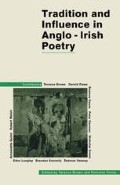Abstract
Yeats’s fondness for associating himself with élite groups, marginalised sects and secret societies is well known. The Dublin Hermetic Society, the Esoteric Section of the Theosophical Society, the Order of the Golden Dawn, the National Literary Society, the Irish Literary Society, the Rhymers’ Club and the Abbey Theatre are the best known of the organised groups to which he belonged and of which he was, in several instances, the founder and guiding spirit. But he was also the publicist for other exclusive movements — Irish folklore, Noh Drama, the eighteenth-century Anglo-Irish ascendancy tradition, Irish nationalism from the Fenian brotherhood to the men of 1916, the Blueshirt movement, the company of poets, Irish, French symbolist, English romantic. All of these affiliations were cherished by Yeats both for their own intrinsic value and for their specific function in the circumstances of contemporary history. That function was the creation of an audience. His writings contain dozens of references to the need for an audience which would be radically different from the mass following which commercial theatre, the literature of Young Ireland, or the popular novel commanded.1 The audience he envisaged would be an integral group, bonded together by a shared ideal or abiding interest. It would be the correlative of the Order of the Golden Dawn:
A Magical Order differs from a society for experiment and research in that it is an actual Being, an organic life holding within itself the highest life of its members.2
Access this chapter
Tax calculation will be finalised at checkout
Purchases are for personal use only
Preview
Unable to display preview. Download preview PDF.
Notes
See Ian Jack, The Poet and His Audience (Cambridge, 1984) pp. 144–68.
Graham Hough, The Mystery Religion of W. B. Yeats (Sussex, 1984) p. 53.
Allan Wade, The Letters of W. B. Yeats (London, 1954) pp. 406–7.
Ibid., p. 166.
John Kelly, The Collected Letters of W. B. Yeats: Volume I 1865–1895 (Oxford, 1986) p. 399.
Autobiographies (London, 1955) pp. 101–2.
Ibid., p. 74.
Essays and Introductions (London, 1961) pp. 510–19.
Ibid., p. 518.
Ibid., p. 526.
Ibid., pp. 513–17.
Ibid., p. 511.
Editor information
Editors and Affiliations
Copyright information
© 1989 Seamus Deane
About this chapter
Cite this chapter
Deane, S. (1989). Yeats: the Creation of an Audience. In: Brown, T., Grene, N. (eds) Tradition and Influence in Anglo-Irish Poetry. Palgrave Macmillan, London. https://doi.org/10.1007/978-1-349-09470-7_3
Download citation
DOI: https://doi.org/10.1007/978-1-349-09470-7_3
Publisher Name: Palgrave Macmillan, London
Print ISBN: 978-1-349-09472-1
Online ISBN: 978-1-349-09470-7
eBook Packages: Palgrave Literature & Performing Arts CollectionLiterature, Cultural and Media Studies (R0)

